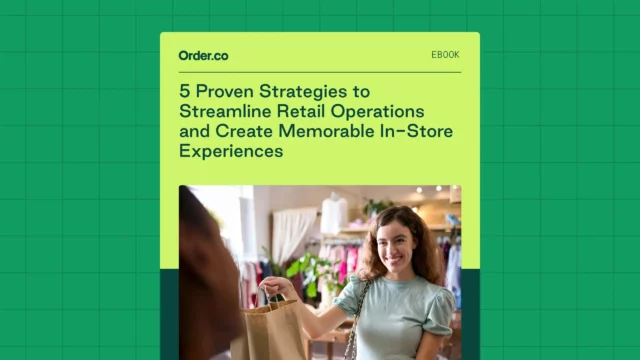Building Stronger Retail Category Management With Technology

Building Stronger Retail Category Management With Technology
Retail procurement is a fast-paced function that demands managers and buyers stay ahead of ever-evolving trends, cost fluctuations, logistics, and (more recently) tariff considerations. It's less about shopping for deals and more about strategizing to secure a competitive edge. Today's buyers must do more than fill shelves—they also need to play a big part in driving a retailer's revenue success.
Category management is one way retailers keep ahead of the curve. It's an approach that enables buyers to curate diverse and appealing product portfolios, build strong supplier relationships, and maintain healthy margins while controlling costs.
This article looks at the nuts and bolts of effective category management and shares how the right technology can enhance the practice further.
What is retail category management?
Retail category management is a strategic approach to procuring and organizing products according to category to better align with customer preferences and increase profitability. It involves detailed analysis, planning, and execution across pricing, product selection, and supplier management to maximize cost efficiency and meet customer demands.
When did category management become popular?
Category management gained steam during the 1990s, with early practices focused on meeting demand through basic market analysis. As ecommerce and social-based buying continue to reshape consumer behavior, category management is growing in scope. Today, successful category management relies on advanced data analytics and customer insights to improve decision-making and create more value in mission-critical categories.
Benefits of implementing retail category management
Category management offers retail sourcing teams operational and financial advantages that help them stay ahead of demand, making it a valuable strategy for inventory management and procurement. Using market research and consumer trends, retailers can fine-tune product assortments, increase customer satisfaction, and streamline supply chains. The result is greater efficiency, better margins, and stronger positioning in the retail market.
Improved inventory efficiency
For retailers, procurement sometimes feels like a no-win situation: Too few products mean stockouts that hinder sales, and too many mean wasted storage space and capital. Both scenarios are major sources of retail cash leaks, which category management helps mitigate by ensuring product selections and quantities reflect demand. This reduces excess stock while improving inventory turnover across categories.
Enhanced supplier relationships
Strong supplier partnerships are the foundation of successful retail procurement. Category management supports these relationships by increasing alignment between procurement goals and supplier capabilities—unlocking better pricing, more favorable contract terms, and improved promotional opportunities. By aligning supplier relationships with category goals, retailers of all sizes can maximize value from their vendor relationships while ensuring reliable access to high-quality goods.
Increased sales and customer loyalty
Data-driven procurement planning is table stakes for modern retail. Without a data-informed approach, retailers risk offering a poor product mix or missing opportunities to integrate high-performing items. Category management, especially when powered by AI-assisted procurement analytics, brings consumer preferences directly into assortment planning. It enables a more accurate product selection, ensuring top items are always front and center. Customers get what they want, and retailers benefit from increased sales and loyalty with less manual effort.
Why the old playbook for retail category management no longer works
Traditional category management methods can no longer keep up with the changing demands of retail procurement. Legacy approaches often rely on intuition and siloed planning processes, overlooking the nuanced data necessary for making informed decisions. While tried-and-true techniques like relationship-building and skilled negotiation are still valuable for achieving cost savings and reducing overhead, today's environment demands tools that help retailers choose the right products and maintain the right inventory levels.
A few key changes reshaping the retail category management include:
- Shifting consumer behaviors and priorities
- Ecommerce growth and the increasing need for omnichannel category strategies
- Ongoing supply chain volatility that requires real-time, agile decision-making
In response to these shifts, AI and ML (machine learning) procurement technologies have emerged as the gold-standard approach for managing modern procurement. They can provide contextual recommendations based on historical buying patterns, current benchmarks, and existing contract parameters, enabling retailers to achieve a level of cost efficiency and responsiveness that traditional methods simply can't match.
A modern playbook for success
To remain competitive, retailers need a fresh set of tools and approaches tailored to the current environment. Here are five critical strategies for creating a modern category management framework.
1. Build resilient, adaptive supply chains
Retailers should prioritize vendors that can pivot quickly during crises and ensure supply availability even in uncertain economic conditions. A full 80 percent of logistics professionals say geopolitical instability is one of the biggest disruptors they face. Planning ahead is essential to minimize the negative effects of global volatility.
2. Rethink what drives growth
Yesterday’s margin strategies (like deep discounting) no longer add value in saturated markets. Instead, focus on value creation through differentiation by offering high-demand products tailored to your target audience.
3. Shift from product focus to portfolio strategy
Rather than analyzing single SKUs, take a bird’s-eye view of entire product categories or portfolios. This approach allows you to measure performance more holistically across interconnected customer journeys.
4. Automate the repetitive, focus on the strategic
Manual data entry and spreadsheet management are major time drains for category managers. Automation tools can lighten the load by handling routine tasks, freeing teams to focus on generating strategic insights.
5. Embrace technology as a core enabler
Modern tools like data analytics, AI-based forecasting, and other integrated systems now play a central role in enabling real-time collaboration and faster, more informed decision-making. Technology leaves more time in the day to take care of higher-value tasks.
The 7-step retail category management process
Category management is both an art and a science. Follow these seven steps to build an effective framework tailored to your business.
1. Define high-value categories
Decide how to group similar products using context from customer behaviors, purchase patterns, and product relationships (such as frequently bundled items). This approach helps manage mission-critical goods and ensures high-value or high-volume products achieve cost efficiency.
2. Define the role of each category
Assign a clear business objective to each category. For example, determine if the category is intended to drive sales, attract new customers, enhance engagement, or generate profits.
3. Assess current performance
Analyze key performance indicators (KPIs) like sales data, shelf placement, and inventory turnover. These insights reveal category strengths, highlight areas for improvement, and help leaders make data-driven decisions to boost profitability.
4. Set objectives and targets
Establish measurable goals to track progress. For instance, aim to increase sales by 10% within a specific timeframe or optimize shelf space by strategically reallocating inventory. Clear targets help teams stay focused on creating tangible results from their efforts over time.
5. Create a management strategy
Develop a game plan to meet your objectives and drive growth. This could involve introducing new SKUs to diversify your product offerings and meet evolving customer needs or collaborating with suppliers on strategic promotions to increase sales and strengthen partnerships.
7. Implement and review
Roll out your strategy across all relevant departments, ensuring alignment among marketing, operations, and supply chain teams. This involves clear communication of objectives, timelines, and responsibilities to ensure everyone is working toward the same goals efficiently and effectively.
Monitor category performance and make adjustments as necessary. Regularly reviewing KPIs helps evaluate progress, identify areas needing improvement, and ensure ongoing alignment with strategic objectives.
The 4 P’s of retail category management
The "4 P’s" of category management are a foundational concept in retail. Here’s how they align with a category management strategy for maximum impact.
- Product: Category management helps you optimize your product assortment by focusing on high-demand, high-margin items. Sales data analysis (especially with an AI-powered tool that offers contextualized results) can identify top-performing new products and highlight those losing steam. Effective product management ensures inventory aligns with customer needs to keep profitability high.
- Pricing: Price analysis enables retailers to remain competitive by aligning pricing with market expectations. Dynamic pricing strategies and spend analysis help teams adjust prices based on demand, competition, and seasonality. This approach ensures pricing is attractive to customers while supporting healthy profit margins.
- Placement: Product placement focuses on strategic merchandising to maximize attention and increase sales. In stores, marketers vie to place their high-demand items in prominent locations, such as at eye level on shelves or across end caps. Online, this translates to well-optimized product pages with engaging visuals, detailed descriptions, and easy navigation. A seamless omnichannel placement strategy helps drive sales and improve customer satisfaction.
- Promotion: Promotion is the art of building buzz and encouraging repeat purchases through targeted marketing strategies. This can include category-wide discounts, bundle deals, seasonal sales, or personalized offers. Promotions are often paired with loyalty programs to reward frequent shoppers and create long-term customer relationships. By leveraging data insights, businesses can tailor promotions to better resonate with individual customers and enhance engagement.
How Order.co powers smarter retail category management
Category management isn’t just about tactics. Effective retail procurement calls for strong processes from strategic sourcing to settlement. Order.co helps retailers turn strategy into centralized, scalable procurement by simplifying buying, increasing visibility, and creating a single source of truth for all spend management activities.
Here’s how the AI-powered Order.co platform can empower your retail business:
- Automated purchasing: Place and manage purchases easily in one centralized system. No more juggling vendors or spreadsheets.
- Spend visibility: Access real-time data to help category managers make smarter, more informed decisions.
- Supplier collaboration: Improve vendor partnerships with aligned order processes and transparent communication.
- Catalog-driven purchasing: Buy from a curated catalog of products that makes it easy to get the goods you need while remaining compliant and adhering to spending guidelines.
- Comprehensive reporting: Review category spend with access to centralized, accurate reporting that lets you see your most important spend categories and line-level information on every transaction.
Ready to see how Order.co helps retailers achieve their goals and drive profitability? Get a demo of Order.co today.
Frequently asked questions about retail category management
Is a category manager the same as a buyer?
Not quite. Category managers oversee purchase planning for one or more product categories. They’re responsible for developing and implementing category-level strategies. Buyers, on the other hand, are more directly involved in the sourcing and procurement process, selecting products and managing purchasing logistics.
What are the 3 types of category management?
- Product-focused management
This approach prioritizes the product itself. The focus is on innovation, quality, and features—based on the belief that a superior product will naturally attract customers, regardless of specific market needs or preferences.
- Market-oriented management
Market-oriented management prioritizes understanding and responding to market trends and industry demands. Businesses using this approach analyze the competitive landscape, track industry shifts, and explore market opportunities to position themselves effectively. The goal is to align business strategies with market needs to stay competitive and relevant.
- Consumer-oriented management
This strategy centers around the customer, with every decision based on meeting their needs and solving their pain points. Businesses gather feedback and tailor products or services to deliver a personalized experience, provide maximum value, and foster customer loyalty.
What does a retail category manager do?
A retail category manager plays a key role in overseeing the success of a specific product category. They are responsible for:
Operational efficiency: Coordinating with cross-departmental teams to optimize inventory, merchandising, and overall performance
Category planning: Analyzing market trends and consumer behavior to develop effective strategies
Supplier negotiations: Securing the best deals and partnerships, ensuring profitability and quality
Pricing strategies: Determining competitive pricing while maintaining healthy margins
Get started
Schedule a demo to see how Order.co can simplify buying for your business.
"*" indicates required fields



